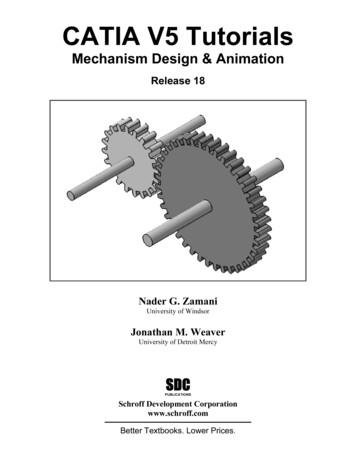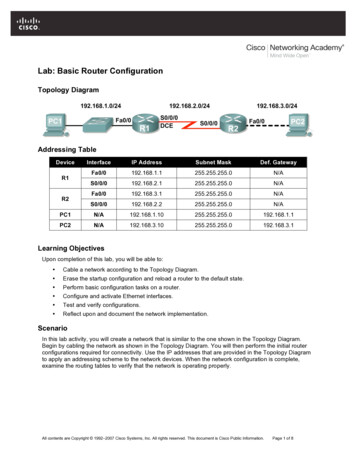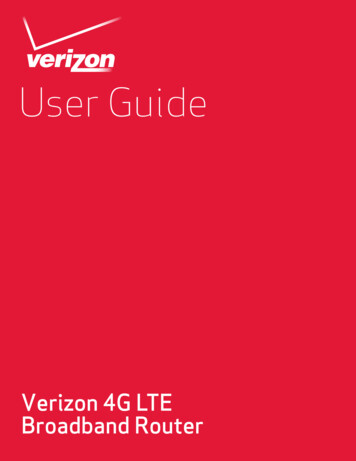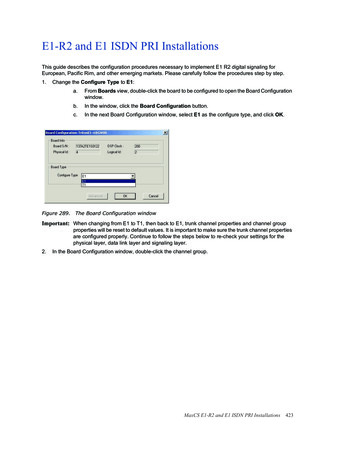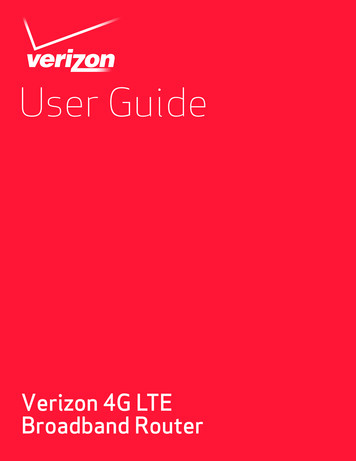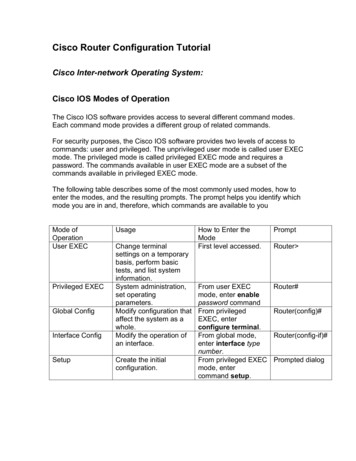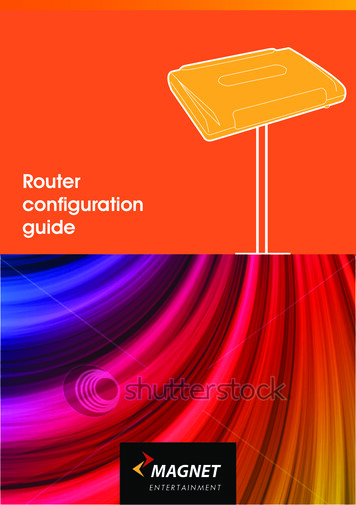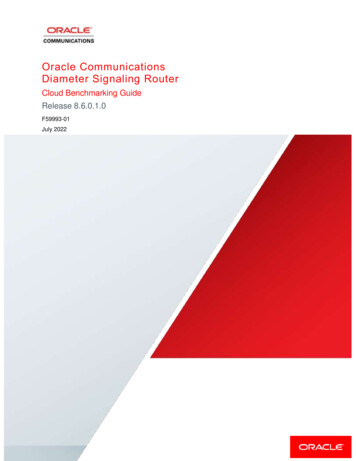
Transcription
Oracle CommunicationsDiameter Signaling RouterCloud Benchmarking GuideRelease 8.6.0.1.0F59993-01July 2022
Table of ContentsIntroduction . 7References . 7Acronyms . 7Terminology . 9About Cloud Deployable DSR . 10What is a Cloud Deployable DSR? . 10Infrastructure Matters . 11Flexibility . 11Methodology . 11Benchmarking Cloud Deployable DSR . 12What to do with all this data?. 12Infrastructure Environment . 13General Rules for All Infrastructures. 14Hyper-Threading and CPU Over-Subscription . 14VM Packing Rate . 15Infrastructure Tuning . 15KVM (QEMU)/Oracle X5-2 – Infrastructure Environment . 15Device Drivers . 16BIOS Power Settings . 16Guest Caching Modes . 16Memory Tuning Parameters . 17VMware (ESXi) – Infrastructure Environment . 18Virtual Sockets vs. Cores per Virtual Socket . 19Network Settings . 19Power Settings . 20Hardware Assisted Virtualization . 20Virtual Machine Storage Configuration . 20Disk Provisioning . 21Benchmark Testing . 21DA MP Relay Benchmark . 21Overview . 21Topology . 22Message Flow . 22Large VM profile for DA-MP . 22Indicative Alarms/Events . 23DA-MP Indicators for Capacity Expansion . 23DA-MP Utilization . 23Measuring DA-MP Connection Utilization . 24Suggested Resolution . 24810K MPS Support . 25Overview . 25Full Address Based Resolution (FABR - SDS) Capacity . 25DSR 8.6.0.1.0 Cloud Benchmarking Guide2
Overview . 25Topology . 26SDS DB Details . 26Message Flow . 26DP Indicators for Capacity Expansion . 27Measuring DP Utilization . 27Full Address Based Resolution (FABR-UDR) Capacity . 28Overview . 28Topology . 28UDR DB Details . 29Message Flow . 29Indicators for Capacity Expansion . 30vSTP MP. 30Overview . 30vSTP MP Benchmarking . 30Note: . 31vSTP MP Indicators for Capacity Expansion . 31Utilization . 31Suggested Resolution . 32Home SMS . 32Overview . 32Home SMS Benchmarking . 32Policy DRA (PDRA) Benchmarking . 33Overview . 33Topology . 33Message Flow . 34Indicative Alarms/Events . 35Measurements . 36Suggested Resolution . 36Diameter Security Application (DSA) Benchmarking . 37Topology . 37Service Capability Exposure Function (SCEF) Benchmarking . 40Topology . 40Suggested Resolution . 41Equipment Identity Register (EIR) . 41NOAM . 41Overview . 41Indicative Alarms/Events . 41Measurements . 42Measuring Network OAM Utilization . 42Suggested Resolution . 42SOAM . 42Overview . 42Indicative Alarms/Events . 42DSR 8.6.0.1.0 Cloud Benchmarking Guide3
Suggested Resolution . 42IPFE. 42Overview . 42Topology . 43Indicative Alarms/Events . 43Suggested Resolution . 44IDIH . 44Overview . 44Suggested Resolution . 44Appendix A. DSR VM Configurations . 44Appendix B. DSR VM Disk Requirements . 47Appendix C. VM Networking Requirements . 48Appendix D. Summary of Benchmark Data Recommendations . 51Appendix E. Detailed Infrastructure Settings . 54Appendix F. Small DSR VM Configuration . 55Appendix G. DSR DA-MP Profiles. 56Infrastructure Performance Differences . 56Traffic Mix . 56VM Configuration . 57Selecting a DA-MP Traffic Profile . 57List of TablesTable 1: Acronyms . 7Table 2: Terminology . 9Table 3: Virtual Network Interrupt Coalescing and SplitRX Mode . 19Table 4: Power Management Profiles . 20Table 5: Virtualization Performance by Processor . 20Table 6: DA-MP Test Set Up . 22Table 7: DA-MP Alarms/Events . 23Table 8: DA-MP Utilization Metrics . 23Table 9: DA-MP Connection Metrics . 24Table 10: SDS DP Message Details . 26Table 11: SDS DP Alarms/Events . 27Table 12: SDS DP Utilization Metrics . 27Table 13: UDR Message Details . 29Table 14: UDR Alarms/Events . 30Table 15: DSR performance benchmarking- UDR based FABR . 30Table 16: Feature-wise vSTP MP Benchmarking . 30Table 17: VSTP-MP Utilization Metrics . 31Table 18: Feature-wise Home SMS Benchmarking . 32DSR 8.6.0.1.0 Cloud Benchmarking Guide4
Table 19: PDRA Test Call Model . 35Table 20: SBR (b) Alarms/Events . 35Table 21: Session SBR (b) VMs Metrics . 36Table 22: Binding SBR (b) Server Metrics . 36Table 23: Stateful and Statelss Counter Measures . 38Table 24: 10K MPS DA-MP VM Profile with Regular UDR profile . 39Table 25: 30K MPS DA-MP VM Profile with Regular UDR profile . 39Table 26: UDR VM Profile . 39Table 27: DAMP combination with UDR Profile . 39Table 28: SCEF DA-MP Server Metrics . 40Table 29: Network OAM Metrics . 42Table 30: System OAM Metrics . 42Table 31: IPFE Throughput . 43Table 32: IPFE Metrics . 43Table 33: VM Configurations and Affinity Rules . 44Table 34: VM Disk Utilization Characteristics . 48Table 35: VM Networking Utilization Characteristics . 49Table 36: Typical OCDSR Network to Device Assignments . 50Table 37: Benchmark Data Summary . 51Table 38: Recommended Maximum Engineering Targets . 51Table 39: Detailed Infrastructure Settings . 54Table 40: Minimal System VM Configurations and Affinity Rules . 55List of FiguresFigure 1: DA-MP Testing Topology . 22Figure 2: DA-MP Message Sequence . 22Figure 3: SDS DP Testing Topology . 26Figure 4: SDS DP Message Sequence . 26Figure 5: UDR Testing Topology . 29Figure 6: UDR Message Sequence . 29Figure 7: SBR Testing Topology . 33Figure 8: PDRA Message Sequence . 34Figure 9: DSA Testing Topology . 37Figure 10: SCEF Testing Topology . 40Figure 11: EIR Testing Topology . 41Figure 12. IPFE on Ingress Side Only . 43DSR 8.6.0.1.0 Cloud Benchmarking Guide5
Figure 13: IPFE on both Ingress and Egress Sides . 43DSR 8.6.0.1.0 Cloud Benchmarking Guide6
IntroductionThe Oracle Communications Diameter Signaling Router (OCDSR or DSR) is deployable in the cloud as aVirtual Network Function (VNF). With DSR’s added flexibility of being cloud deployable, operators mustbe able to manage the capacity and performance of the DSR in the cloud.This document focuses on: How to benchmark DSR performance and capacity in a cloud deployed DSR Provides recommendations on performance tuning the DSR Provides benchmark data from our labs Provides information on the key metrics used to manage DSR performance and capacity Provides recommendations on how to use the data obtained from the metricsReferences[1] Performance Best Practices for VMware vSphere 6.0 s-vsphere6-0-white-paper.pdfThe following are available at Oracle.com on the Oracle Help Center (OHC):[2] DSR Alarms, KPIs, and Measurements[3] DSR Cloud Deployable Installation Guide[4] Policy and Charging Application User’s GuideAcronymsTable 1: AcronymsAcronymDescriptionAPIApplication Programming InterfaceARRApplication Route RuleARTApplication Route TableCMCounter MeasureCOTSCommercial Off the ShelfCPUCentral Processing UnitDA-MPDiameter Agent Message ProcessorDBDatabaseDPDatabase ProcessorDSADiameter Security ApplicationDSRDiameter Signaling RouterEIREquipment Identity RegisterETGEgress Throttle GroupFABRFull Address Based ResolutionFQDNFully Qualified Domain NameGBGigabyteHDDHard Disk DriveDSR 8.6.0.1.0 Cloud Benchmarking Guide7
AcronymDescriptionHPHewlett PackardHSSHome Subscriber ServerHTTPHypertext Transfer ProtocolIDIdentificationIDIHIntegrated Diameter Intelligence HubIMIInternal Message InterfaceIMSIInternational Mobile Subscriber net of ThingsIPInternet ProtocolIPCANInternet Protocol Connectivity Access NetworkIPFEIP Front EndKPIKey Performance IndicatorKSMKernel Same-page MergingKVMKernel-based virtual machineLSILarge Scale IntegrationLTELong Term EvolutionMD-IWFMAP-Diameter Interworking FunctionMMEMobility Management EntityMNOMobile Network OperatorMPMessage ProcessorMPSMessages Per SecondMSISDNMobile Station International Subscriber Directory NumberMTCMachine Type CommunicationNICNetwork Interface CardNOAMNetwork Operations, Alarms, MeasurementsNENetwork ElementOAMOperations, Administration, and MaintenanceOCDSROracle Communications Diameter Signaling RouterOCSGOracle Communications Services GatekeeperOHCOracle Help CenterPCRFPolicy and Charging Rules FunctionPDRAPolicy Diameter Routing AgentPRRPeer Route RulePVSCSIParavirtual SCSIRAMRandom Access MemoryRBARRange Based Address ResolutionSASSerial Attached SCSCDSR 8.6.0.1.0 Cloud Benchmarking Guide8
AcronymDescriptionSCEFService Capabilities Exposure FunctionSBRSession Binding RepositorySBR(b)SBR – subscriber binding databaseSBR-gSBR(s)SBR – session databaseSBR(u)SBR – universal databaseSCS/ASService Centralization and Continuity Application ServerSCSISmall Computer System InterfaceSDSSubscriber Database ServerSFFSmall Form FactorSGSNServing GPRS Support NodeSMSShort Message ServiceSOAMSystem (nodal) Operations, Alarms, MeasurementsSS7Signaling System #7SSDSolid State DriveTHPTransparent Huge PagesTSATarget Set AddressTTPTroubleshooting Trigger PointvSTPvirtual Signaling Transfer PointUDR-NOUser Data Repository Network OAM & ProvisioningU-SBRUniversal SBRVMVirtual MachineVNFVirtual Network FunctionVoLTEVoice over LTEWANWide Area NetworkXMIExternal Management InterfaceXSIExternal Signaling InterfaceTerminologyTable 2: TerminologyTermDescription1 1RedundancyFor every 1, an additional 1 is needed to support redundant capacity. The specificredundancy scheme is not inferred (for example, active-active, and active-standby).Geo-DiverseRefers to DSR equipment located at geographically separated sites/datacentersGeoRedundantA node at a geo-diverse location which can assume the processing load for anotherDSR signaling node(s)IngressMessageRateA measure of the total Diameter messages per second ingressing the DSR. For thismeasure, a message is defined as any Diameter message that DSR reads from aDiameter peer connection independent of how the message is processed by the DSR.DSR 8.6.0.1.0 Cloud Benchmarking Guide9
TermDescriptionMessagesPer SecondA measure of the DSR Diameter message processing volume in messages per second.For this measure, a message is defined as: DSR processing of an ingress Diameter message and either transmitting a singleoutgoing Diameter message or discarding the ingress message. The outgoingmessage may be a variant of, or a response to, the ingress message. DSR transmission of any Diameter message, as required by DSR configuration,that is associated with incremental actions/events associated with #1 above. Forexample, the re-routing of a Request upon connection failure or the copying of aRequest.Messages excluded from this measure are: Diameter peer-to-peer messages: CER/CEA, DWR/DWA, and DPR/DPA Ingress Diameter messages discarded by the DSR due to Overload controls Answers received in response to Message CopyFor the vSTP MP the MPS excludes the equivalent SSNM status managementmessages.N KRedundancyFor every N, an additional K is needed to support redundant capacity. The specificredundancy scheme is not inferred (for example, active-active, active-standby).NodeA DSR node is a DSR signaling node (SOAM and subtending topology), an NOAMnode or an SDS node. A node is synonymous with the network element (NE).SiteA specific geographic location or datacenter where DSR application is installed.About Cloud Deployable DSRDSR is deployed on a number of platforms. The DSR has a multiple deployment scenarios: Bare-metal and hybrid (mixture of bare metal and virtual machines) — is the original deploymentconfiguration of the DSR. It scales to very high performance and is widely deployed. Fully virtualized — was introduced shortly after bare-metal. It provides virtualization of the DSR, butdoes not use a cloud manager, and does not co-reside with other applications. Provides a compact,cost-effective footprint and is widely deployed. Cloud deployable – It provides full virtualization, assumes the DSR resources are managed by aCOTS cloud manager, and the DSR can be one of many applications in the cloud. Cloud deployableDSR is the focus of this document. Mix and match – DSR is a network of DSR signaling sites. The deployment infrastructure at each sitecan vary, for example, bare-metal at one site, and then cloud deployed at another location.What is a Cloud Deployable DSR?A DSR that is ready and able to be deployed into a number of different cloud environments, including butnot limited to: A customer provided cloud infrastructure. The DSR is simply one of many applications. A dedicated private cloud. The DSR may be the only application, or one of a small set ofapplications. Services and infrastructure may also be provided by Oracle and deployed at customer’ssites. Often (but not necessarily) this is a deployment tuned specifically for the DSR. A hosted cloud. The DSR is deployed in an Oracle or operator hosting cloud, and end-customersrent or lease the DSR application from the hosting provider.DSR 8.6.0.1.0 Cloud Benchmarking Guide10
Infrastructure MattersThe DSR is capable of running on a huge variety of infrastructures, but not all infrastructures are thesame. The performance, capacity, and latency of the DSR can vary dramatically based on the choseninfrastructure and how it is deployed. In general, the DSR works best in a high bandwidth, low-latency,high processing power environment (carrier grade cloud). Some considerations that impact DSRperformance, capacity, latency: Hardware – the CPUs and NICs (network interface cards) Hypervisor settings/configuration Uplinks, switches, WAN latency Storage configuration (local, networked)DSR has excellent high availability and geo-diversity resiliency mechanisms that work in concert withcloud manager capabilities. Obviously, the needed scale, availability, and resiliency of the deploymentalso impact the resource and infrastructure requirements.FlexibilityDSR is flexibly deployed into many different clouds. It is unlikely that any two clouds are exactly thesame and operators need to optimize for different reasons (for example, power consumption may becritical for one operator, and WAN latency at another), varying sets of applications, and differingoperational requirements. The performance and capaci
VMware (ESXi) - Infrastructure Environment There are a number of ESXi (VMware hypervisor) settings that affect performance of the hosted virtual machines. A number of tests were performed to maximize the performance of the underlying virtual machines for the DSR application. Hypervisor versions tested ESXi 5.5 ESXi 6.0 U2


